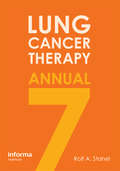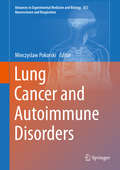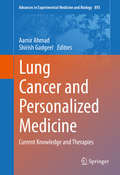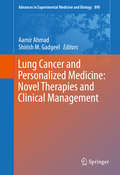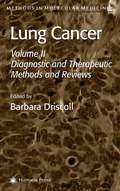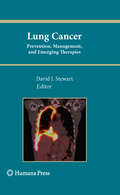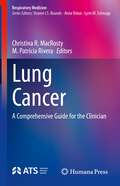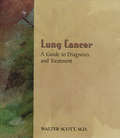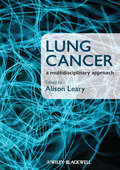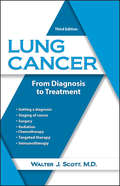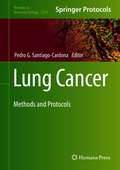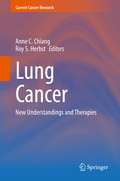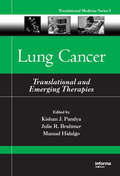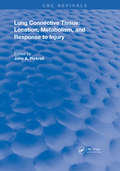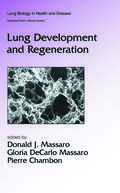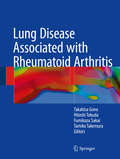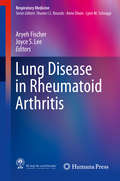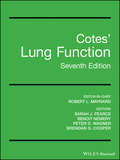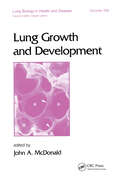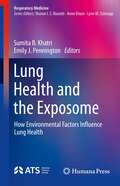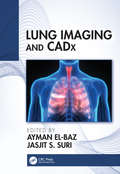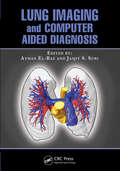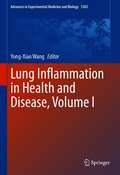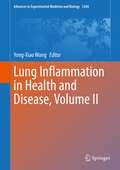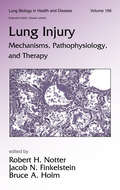- Table View
- List View
Lung Cancer Therapy Annual 7
by Rolf A. StahelOncology research and practice in lung cancer continues to develop rapidly. This latest edition of Lung Cancer Therapy Annual briefs the oncology community with a review of the recent literature, emphasizing the therapeutic aspects. It offers an update of the impact that this information will have on the day-to-day management of the lung cancer pat
Lung Cancer and Autoimmune Disorders
by Mieczyslaw PokorskiLung cancer and autoimmune diseases are complex entities in that they involve gene disturbance, gene polymorphism, and impaired gene repair mechanisms. The volume focuses on altered gene expression in tumor processes and in chronic autoimmune disorders. The chapters discuss the biological rationale for novel disease protein markers, present relevant clinical results, and give some diagnostic and therapeutic tips.
Lung Cancer and Personalized Medicine
by Aamir Ahmad Shirish GadgeelThis, the first of two volumes on personalized medicine in lung cancer, touches on the core issues related to the understanding of lung cancer--statistics and epidemiology of lung cancer--along with the incidence of lung cancer in non-smokers. A major focus of this volume is the state of current therapies against lung cancer--immune, targeted therapies against EGFR TKIs, KRAS, ALK, angiogenesis; the associated challenges, especially resistance mechanisms; and recent progress in targeted drug development based on metal chemistry. Chapters are written by some of the leading experts in the field, who provide a better understanding of lung cancer, the factors that make it lethal, and current research focused on developing personalized treatment plans. With a unique mix of topics, this volume summarizes the current state-of-knowledge on lung cancer and the available therapies.
Lung Cancer and Personalized Medicine: Novel Therapies and Clinical Management
by Aamir Ahmad Shirish M. GadgeelThis, the second of two volumes on personalized medicine in lung cancer, touches upon the recent progress in targeted drug development based on genomics; emerging biomarkers and therapeutic targets such as EMT, cancer stem cells, and the tumor microenvironment; current personalized clinical management and radiation therapy for lung cancers; and the promise of epigenetics and next-generation sequencing for the advancements towards personalized therapy of lung cancer patients. With chapters on state-of-the-art therapies and technologies written by leading experts working to develop novel companion diagnosis tools for the personalized treatment of lung cancer patients, this volume brings readers up-to-date by presenting the current knowledge on the efforts to make personalized management of lung cancer patients a reality.
Lung Cancer, Volume 2: Diagnostic and Therapeutic Methods and Reviews
by Barbara DriscollLeading physician scientists and noted researchers review novel methods for determining the etiology of a variety of lung cancers and present readily reproducible techniques for examining the associated multitude of genetic abnormalities. The methods make it possible to detect these alterations at the cellular, DNA, and protein levels, to study the development of lung cancer in vitro and in vivo-either in situ or in the form of metastases, and to test targeted therapies with detailed model systems. An animal models section gives explicit instructions for setting up and testing these systems, which are rarely described in the literature.
Lung Cancer:
by David J. StewartThis comprehensive resource provides authoritative knowledge of the most up-to-date prevention and treatment strategies for thoracic malignancies. Established and investigational therapies are placed in the context of tumor biology for a full understanding of the pharmacogenetics, etiology, and changing epidemiology of lung cancer. Expert clinicians detail the function of predictive and prognostic factors in the utilization of chemo-radiotherapy, adjuvant and neoadjuvant treatment, and targeted agents. The promises and potential pitfalls of investigational strategies are evaluated with exceptional insight and clarity, with unique attention paid to the mechanisms of drug resistance and targets for lung cancer treatment and prevention. Lung Cancer: Prevention, Management, and Emerging Therapies engages the entire spectrum of therapeutic modalities with focus on systemic approaches. Disease coverage includes newly diagnosed and recurrent non-small cell lung cancer, small cell carcinoma, and mesothelioma. Critical examination of the impact, methodology, and design of clinical trials is presented along with new paradigms for personalized approaches and individual risk assessment.
Lung Cancer: A Comprehensive Guide for the Clinician (Respiratory Medicine)
by Christina R. MacRosty M. Patricia RiveraThis book provides a comprehensive yet succinct update for the clinician in the diagnosis, staging, and treatment of lung cancer. Lung cancer is a leading cause of death in the US and worldwide and its prevention, screening, and treatment is a large part of clinical practice across specialties. Frequent updates in recommendations and guidelines in screening, diagnosis, staging, treatment, and management are vital, and it can be difficult for the busy clinician to stay up to date. This book provides a comprehensive update for the chest clinician across the continuum of lung cancer care. Each of the thirteen chapters covers a specific component of lung cancer care and is written by experts in the field who are practicing clinicians. The objectives are to provide an organized and easily-referenced resource for the chest clinician; to provide comprehensive evidence-based information on the following topics: lung cancer screening and prevention, approach to lung nodules, diagnosis and staging of lung cancer, treatment of lung cancer, pleural disease in lung cancer, and treatment complications; and to provide source information for clinicians so they can stay up-to-date on any new guidelines or recommendations related to lung cancer screening, tobacco treatment, staging, and diagnosis. This book is written specifically for the busy clinician that focuses on clinically relevant and evidence-based principles around lung cancer while providing references for ease of finding source information to enable clinicians to stay updated as guidelines change. This is an ideal guide for practicing pulmonary clinicians, practicing general practice clinicians, trainees in chest and general medicine, as well as some advanced practice providers who need a refresher.
Lung Cancer: A Guide to Diagnosis and Treatment
by Walter J. ScottWhat is my prognosis? What are my treatment options? Which therapies would be the most effective for my stage of lung cancer? These and other frequently asked questions are addressed in this crucial reference designed to help patients educate themselves and obtain the best possible treatments. The completely revised second edition has been updated to include a discussion of the movement towards customized chemotherapy; treatment options for early-stage lung cancer including minimally invasive surgery; and the most promising treatments, among them multimodality therapy—a combination of surgery, chemotherapy, and radiation. Dr. Scott also surveys tests for early detection of lung cancer, talks about the importance of cancer staging, examines alternative treatments, and offers advice on coping with emotions such as "smoker's guilt."
Lung Cancer: A Multidisciplinary Approach
by Alison LearyLung Cancer: A Multidisciplinary Approach provides clinicians with a comprehensive text that can be used when caring for patients with lung cancer throughout the entire patient journey. This edited collection explores the aetiology of lung cancer; mesothelioma; the range of available treatments, including chemotherapy and radiotherapy; surgical care; supportive and end-of-life care; quality-of-life issues; and the role of the nurse within the multidisciplinary team. A comprehensive, evidence-based guide to lung cancer Illustrative case studies used throughout Contributions from respected healthcare professionals in the field Interprofessional in focus Lung Cancer: A Multidisciplinary Approach is an essential resource for all nurses and healthcare professionals working with cancer patients.
Lung Cancer: From Diagnosis to Treatment
by Walter ScottAccording to the American Cancer Society, nearly 220,000 Americans are diagnosed with lung cancer annually. It accounts for nearly 15 percent of all newly diagnosed cancers. If you've been diagnosed, you probably have many questions about the nature of the disease and your treatment options.Walter J. Scott, M.D., has treated thousands of lung cancer patients who have navigated this overwhelming maze of medical tests and procedures. In Lung Cancer: From Diagnosis to Treatment, Dr. Scott helps you understand the process—from getting a diagnosis to going through treatment. He explains topics such as: symptoms of lung cancer, diagnostic tests, types and stages of lung cancer, surgical procedures, chemotherapy, radiation therapy, clinical trials, coping with "smoker's guilt" and more. A book to help you become an informed patient!
Lung Cancer: Methods and Protocols (Methods in Molecular Biology #2279)
by Pedro G. Santiago-CardonaThis detailed book serves as a laboratory manual containing vital protocols and in-depth discussion involving commonly used experimental approaches for the characterization of several aspects of lung tumor biology. Beginning with an extensive section on biomarker detection, the volume continues with chapters on the genetic and molecular characterization of lung cancer biological samples as well as protocols for the generation of research tools and pre-clinical lung cancer models. Written for the highly successful Methods in Molecular Biology series, chapters include introductions to their respective topics, lists of the necessary materials and reagents, step-by-step, readily reproducible protocols, and tips on troubleshooting and avoiding known pitfalls. Authoritative and practical, Lung Cancer: Methods and Protocols provides a global perspective of research efforts related to lung cancer, while allowing researchers to experimentally probe the different aspects of lung cancer research, including the experimentally relevant tests used in the establishment of lung cancer diagnosis and prognosis, in their laboratories.
Lung Cancer: New Understandings and Therapies (Current Cancer Research)
by Anne C. Chiang Roy S. HerbstLung cancer has seen a paradigm shift in disease treatment over the past few years, with major changes in the therapeutic drugs now available as well as in the overall management approach. For targeted and immunotherapeutic approaches, understanding the biology of acquired resistance is a key strategy that has yielded productive advances in the subsequent treatment. Future advances also include incorporating biomarker data obtained from solid and liquid biopsies, as well as combination of immunotherapy with radiotherapy and in special populations such patients with CNS involvement.
Lung Cancer: Translational and Emerging Therapies
by Manuel Hidalgo Kishan J. Pandya Julie R. BrahmerLung cancer is the leading cause of cancer-related deaths in the United States. Filling a gap in the literature, this resource translates recent laboratory findings into practical applications for the prevention and control of lung cancer. Featuring chapters by seasoned researchers in the field, this reference reviews current advances in imaging, d
Lung Connective Tissue: Location, Metabolism, and Response to Injury (Routledge Revivals)
by D. V. M. John A. PickreilFirst Published in 1981, this book offers a full, comprehensive guide into the connective tissue of the lung and its relationship to our environment and health. Filled with a vast repertoire of factual data and statistics, this book serves as a useful reference for Students of Medicine, and other practitioners in their respective fields.
Lung Development and Regeneration (Lung Biology in Health and Disease)
by Donald J. Massaro Gloria DeCarlo Massaro Pierre ChambónThis reference compiles the most current technical and biological data available to survey the state-of-science in the care and management of patients with bronchopulmonary dysplasia, COPD, and other forms of lung disease-tracking the initiation and progression of processes that cause airway obstruction, the biologic and physiological abnormalities
Lung Disease Associated with Rheumatoid Arthritis
by Takahisa Gono Hitoshi Tokuda Fumikazu Sakai Tamiko TakemuraThis comprehensive text expounds the pathophysiology, diagnosis, and treatment of lung disease associated with rheumatoid arthritis (RA), an autoimmune disease that primarily affects joints. Recent advances in therapy for RA provide the benefit of achieving a better outcome in patients with arthritis, and a large number of reports on RA are now available. Moreover, the American College of Rheumatology and the European League Against Rheumatism have proposed guidelines and recommendations for management of RA patients. Therefore, clinicians around the world can adequately understand how to manage patients who have joint symptoms in RA. At the same time, however, the management of RA patients who have lung problems has not been disseminated sufficiently, although lung disease is a common complication in approximately 30–40 % of patients with RA. Unfortunately, there has been a lack of tangible evidence regarding the pathophysiology, diagnosis, and management of lung disease associated with RA. Each expert author in this book elucidates the current status of knowledge about lung disease in RA and the management of RA patients with lung diseases. Thus this valuable collection benefits not only rheumatologists but also respirologists, radiologists, pathologists, general practitioners, and medical staff such as nurses who are involved in the management of RA.
Lung Disease in Rheumatoid Arthritis
by Aryeh Fischer Joyce S. LeeThis book addresses the manifestation of lung disease in patients with rheumatoid arthritis (RA). Lung disease in RA is common and often associated with significant morbidity and mortality. This stems partially from the nature of RA and partially from the many therapies used to manage RA that are associated with pneumotoxicity. Despite the severity and commonality of this comorbidity, little has been written on the topic. This book thus takes a multidisciplinary approach to provide: a concise overview of RA and why lung disease so commonly coincides with it; overviews of the specific lung diseases, including interstitial lung disease, and their epidemiology, associated imaging, histopathology, biomarkers, and management; a presentation of risk factors for these diseases; and specifics on what still needs to be uncovered about these pulmonary manifestations. Lung Disease in Rheumatoid Arthritis is a comprehensive and practical resource for clinicians and clinician scientists in pulmonology, rheumatology, pathology, and primary care.
Lung Function
by Benoit Nemery Sarah J. Pearce Peter D. Wagner Robert L. Maynard Brendan G. CooperThe seventh edition of the most authoritative and comprehensive book published on lung function, now completely revised and restructured Lung function assessment is the central pillar of respiratory diagnosis. Most hospitals have lung function laboratories where patients are tested with a variety of physiological methods. The tests and techniques used are specialized and utilize the expertise of respiratory physicians, physiologists, and technicians. This new edition of the classic text on lung function is a theoretical textbook and practical manual in one that gives a comprehensive account of lung function and its assessment in healthy persons and those with all types of respiratory disorder, against a background of respiratory, exercise, and environmental physiology. It incorporates the technical and methodological recommendations for lung function testing of the American Thoracic Society and European Respiratory Society. Cotes' Lung Function, 7th Edition is filled with chapters covering respiratory surveys, respiratory muscles, neonatal assessment, exercise, sleep, high altitude, hyperbaria, the effects of cold and heat, respirable dusts, fumes and vapors, anesthesia, surgery, and respiratory rehabilitation. It also offers a compendium of lung function in selected individual diseases and is filled with more diagrams and illustrative cases than previous editions. The only text to cover lung function assessment from first principles including methodology, reference values, and interpretation Completely re-written in a contemporary style—includes user-friendly equations and more diagrams Covers the latest advances in the treatment of lung function, including a stronger clinical and practical bias and more on new techniques and equipment Keeps mathematical treatments to a minimum Cotes' Lung Function is an ideal guide for respiratory physicians and surgeons, staff of lung function laboratories, and others who have a professional interest in the function of the lungs at rest or on exercise and how it may be assessed. Physiologists, anthropologists, pediatricians, anesthetists, occupational physicians, explorers, epidemiologists, and respiratory nurses should also find the book useful.
Lung Growth and Development (Lung Biology in Health and Disease)
by John A. McDonaldReflects the explosion of information and technological breakthroughs that have facilitated investigations into the development of the lung-including recombinant DNA technology, molecular genetics, transgenics, and advances in lung cell and mo-lecular biology. Provides nearly 2800 bibliographic citations and over 170 tables, drawings, and x-rays to help clarify specific discussions.
Lung Health and the Exposome: How Environmental Factors Influence Lung Health (Respiratory Medicine)
by Sumita B. Khatri Emily J. PenningtonThis book is ideal for the practicing clinician looking to better understand how our environment impacts the lung. A compilation of reviews explores how clinicians can be aware and better determine environmental effects on lung health, and provides guidelines for medical providers to diagnose, counsel and mitigate risk. Various lung diseases are affected by the external environment. Asthma is common, however other airways diseases, such as interstitial lung disease, malignancies, and even adverse effects from reactions treatments for other medical conditions can affect the health of the lungs. While there are books and chapters written on occupational lung disease and environmental causes of asthma, the intent of this body of work is to address the exposome and the effects on a broader group of lung disease. In addition to information on traditional exposure sources, such as air pollution and occupational exposures, this resource explores newer areas of interest, including lung disease from recreational inhalants and the role of climate change on lung health. Written by expert respiratory specialists, the articles cover a wide range of topics, including: How air pollution effects airways disease, including asthma, COPD, and cystic fibrosis Risk factors and effects of indoor mold exposure Both medical and non-medical exposures that increase the risk of or cause interstitial lung disease (ILD) also known as diffuse parenchymal lung disease (DPLD) Acute and chronic lung disease associated with recreational inhalants The epidemiologic and molecular mechanisms of air pollution effects on pulmonary hypertension Climate change and weather-related lung health issues Areas in this field that need further evaluation
Lung Imaging and CADx
by Jasjit Suri Ayman El-BazDeveloping an effective computer-aided diagnosis (CAD) system for lung cancer is of great clinical importance and can significantly increase the patient's chance for survival. For this reason, CAD systems for lung cancer have been investigated in a large number of research studies. A typical CAD system for lung cancer diagnosis is composed of four main processing steps: segmentation of the lung fields, detection of nodules inside the lung fields, segmentation of the detected nodules, and diagnosis of the nodules as benign or malignant. This book overviews the current state-of-the-art techniques that have been developed to implement each of these CAD processing steps. Overviews the latest state-of-the-art diagnostic CAD systems for lung cancer imaging and diagnosis Offers detailed coverage of 3D and 4D image segmentation Illustrates unique fully automated detection systems coupled with 4D Computed Tomography (CT) Written by authors who are world-class researchers in the biomedical imaging sciences Includes extensive references at the end of each chapter to enhance further study Ayman El-Baz is a professor, university scholar, and chair of the Bioengineering Department at the University of Louisville, Louisville, Kentucky. He earned his bachelor’s and master’s degrees in electrical engineering in 1997 and 2001, respectively. He earned his doctoral degree in electrical engineering from the University of Louisville in 2006. In 2009, he was named a Coulter Fellow for his contributions to the field of biomedical translational research. He has 17 years of hands-on experience in the fields of bio-imaging modeling and noninvasive computer-assisted diagnosis systems. He has authored or coauthored more than 500 technical articles (132 journals, 23 books, 57 book chapters, 211 refereed-conference papers, 137 abstracts, and 27 U.S. patents and disclosures). Jasjit S. Suri is an innovator, scientist, a visionary, an industrialist, and an internationally known world leader in biomedical engineering. He has spent over 25 years in the field of biomedical engineering/devices and its management. He received his doctorate from the University of Washington, Seattle, and his business management sciences degree from Weatherhead School of Management, Case Western Reserve University, Cleveland, Ohio. He was awarded the President’s Gold Medal in 1980 and named a Fellow of the American Institute of Medical and Biological Engineering for his outstanding contributions in 2004. In 2018, he was awarded the Marquis Life Time Achievement Award for his outstanding contributions and dedication to medical imaging and its management.
Lung Imaging and Computer Aided Diagnosis
by Jasjit S. Suri Ayman El-BazLung cancer remains the leading cause of cancer-related deaths worldwide. Early diagnosis can improve the effectiveness of treatment and increase a patient's chances of survival. Thus, there is an urgent need for new technology to diagnose small, malignant lung nodules early as well as large nodules located away from large diameter airways because
Lung Inflammation in Health and Disease, Volume I (Advances in Experimental Medicine and Biology #1303)
by Yong-Xiao WangRespiratory diseases are leading causes of death and disability globally, with about 65 million people suffering from COPD, and 334 million from asthma, the most common chronic disease. Each year, tens of millions of people develop and can die from from respiratory infections such as pneumonia and TB. Systemic inflammation may induce and exacerbate local inflammatory diseases in the lungs, and local inflammation can in turn cause systemic inflammation. There is increasing evidence of the coexistence of systemic and local inflammation in patients suffering from asthma, COPD, and other lung diseases, and the co-morbidity of two or more local inflammatory diseases often occurs. For example, rheumatoid arthritis frequently occurs together with, and promotes the development of, pulmonary hypertension. This co-morbidity significantly impacts quality of life, and can result in death for those affected.Current treatment options for lung disease are neither effective, nor condition-specific; there is a desperate need for novel therapeutics in the field. Additionally, the molecular and physiological significance of most major lung diseases is not well understood, which further impedes development of new treatments, especially in the case of coexistent lung diseases with other inflammatory diseases. Great progress has been made in recent years in many areas of the field, particularly in understanding the molecular geneses, regulatory mechanisms, signalling pathways, and cellular processes within lung disease, as well as basic and clinical technology, drug discovery, diagnoses, treatment options, and predictive prognoses. This is the first text to aggregate these developments. In two comprehensive volumes, experts from all over the world present state-of-the-art advances in the study of lung inflammation in health and disease. Contributing authors cover well-known as well as emerging topics in basic, translational, and clinical research, with the aim of providing researchers, clinicians, professionals, and students with new perspectives and concepts. The editors hope these books will also help to direct future research in lung disease and other inflammatory diseases, and result in the development of novel therapeutics.
Lung Inflammation in Health and Disease, Volume II (Advances in Experimental Medicine and Biology #1304)
by Yong-Xiao WangLung diseases are leading causes of death and disability globally, with about 65 million people suffering from COPD, and 334 million from asthma. Each year, tens of millions of people develop and can die from lung infections such as pneumonia and TB. Systemic inflammation may induce and exacerbate local inflammatory diseases in the lungs, and local inflammation can in turn cause systemic inflammation. There is increasing evidence of the coexistence of systemic and local inflammation in patients suffering from asthma, COPD, and other lung diseases, and the co-morbidity of two or more local inflammatory diseases often occurs. For example, rheumatoid arthritis frequently occurs together with, and promotes the development of, pulmonary hypertension. This co-morbidity significantly impacts quality of life, and can result in death for some patients. Current treatment options for lung disease are neither always effective, nor condition-specific; there is a desperate need for novel therapeutics in the field. Additionally, the molecular and physiological significance of most major lung diseases is not well understood, which further impedes development of new treatments, especially in the case of coexistent lung diseases with other inflammatory diseases. Great progress has been made in recent years in many areas of the field, particularly in understanding the molecular geneses, regulatory mechanisms, signalling pathways, and cellular processes within lung disease, as well as basic and clinical technology, drug discovery, diagnoses, treatment options, and predictive prognoses. This is the first text to aggregate these developments. In two comprehensive volumes, experts from all over the world present state-of-the-art advances in the study of lung inflammation in health and disease. Contributing authors cover well-known as well as emerging topics in basic, translational, and clinical research, with the aim of providing researchers, clinicians, professionals, and students with new perspectives and concepts. The editors hope these books will also help to direct future research in lung disease and other inflammatory diseases, and result in the development of novel therapeutics.
Lung Injury: Mechanisms, Pathophysiology, and Therapy (Lung Biology in Health and Disease)
by Robert H. Notter Jacob N. Finkelstein Bruce A. HolmProgressing from general scientific principles and concepts to in-depth topical discussions of current research and treatment methods, this comprehensive reference defines the cellular and molecular mechanisms contributing to inflammatory lung injury and repair. Extensive coverage is provided on key mediators and pathways important in acute and chr
